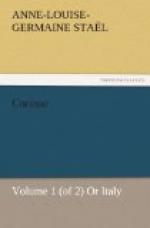Chapter iii.
Raphael has said that modern Rome was almost entirely built with the ruins of the ancient city, and it is certain that we cannot take a step here without being struck by some relics of antiquity. We perceive the eternal walls, to use the expression of Pliny, through the work of the later centuries; the Roman edifices almost all bear a historical stamp; in them may be remarked, if we may so express it, the physiognomy of ages. From the Etruscans to our days, from that people, more ancient than the Romans themselves, and who resembled the Egyptians by the solidity of their works and the fantastical nature of their designs, from that people to Chevalier Bernini, an artist whose style resembles that of the Italian poets of the seventeenth century, we may observe the human mind at Rome, in the different characters of the arts, the edifices and the ruins. The middle ages, and the brilliant century of the Medici, re-appear before our eyes in their works, and this study of the past in objects present to our sight, penetrates us with the genius of the times. It was believed that Rome had formerly a mysterious name which was only known to a few adepts; it seems that it is yet necessary to be initiated into the secret of this city. It is not simply an assemblage of habitations, it is the history of the world, figured by divers emblems and represented under various forms.
Corinne agreed with Lord Nelville that they should go and visit together, the edifices of modern Rome, and reserve for another opportunity the admirable collections of pictures and statues which it contains. Perhaps, without accounting for it to herself, she desired to put off till the most distant day possible, those objects which people cannot dispense with seeing at Rome; for who has ever quitted it without having contemplated the Apollo Belvedere and the pictures of Raphael? This guarantee, weak as it was, that Oswald should not leave her, pleased her imagination. Is there not an element of pride some one will ask, in endeavouring to retain the object of our love by any other means than the real sentiment itself? I really do not know; but the more we love, the less we trust to the sentiment we inspire; and whatever may be the cause which secures the presence of the object who is dear to us, we always embrace it joyfully. There is often much vanity in a certain species of boldness, and if charms, generally admired, like those of Corinne, possess a real advantage, it is because they permit us to place our pride to the account of the sentiment we feel rather than to that which we inspire.
Corinne and Nelville began their observations by the most remarkable of the numerous churches of Rome—they are all decorated with ancient magnificence; but something gloomy and fantastical is mingled with that beautiful marble and those festival ornaments which have been taken from the Pagan temples. Pillars of porphyry and granite were so numerous in Rome that they have lavishly distributed them, scarcely considering them of any value. At St John Lateran, that church so famous for the councils that have been held in it, are found such a quantity of marble pillars that many of them have been covered with a cement of plaster to make pilasters, so indifferent have they become to these riches from their multitude.




